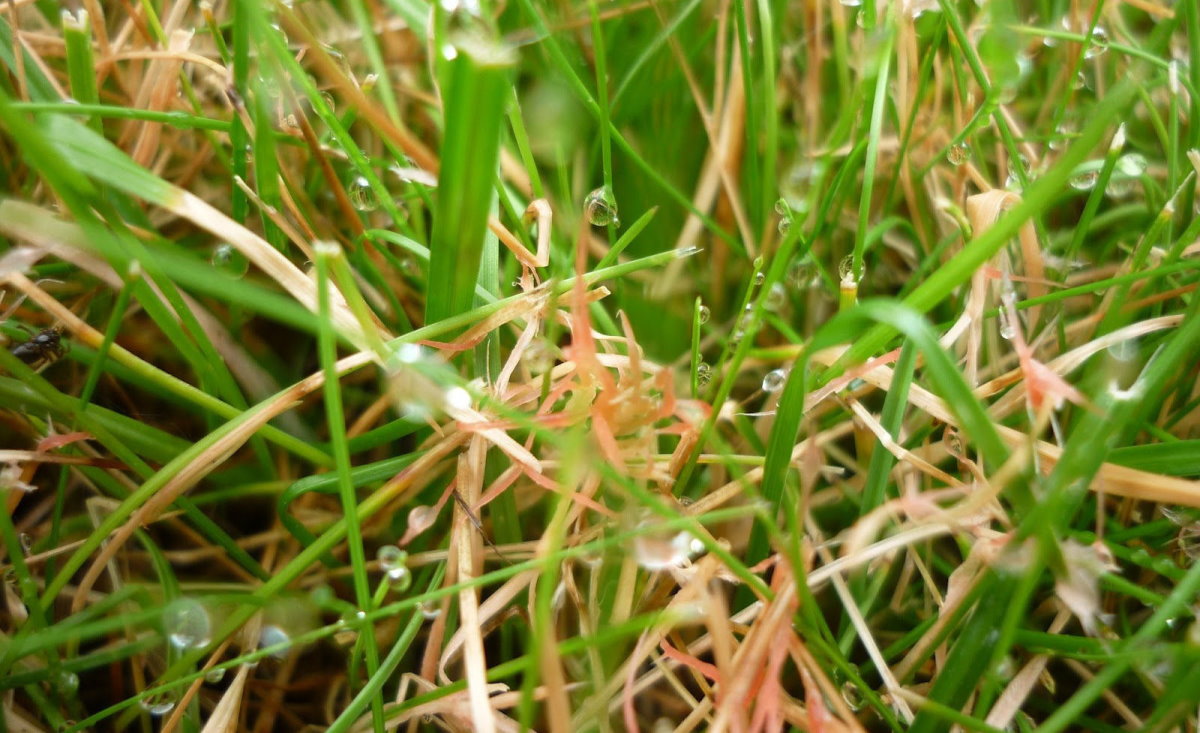
If you’re seeing patches of withering grass in your yard with a tell-tale pinkish tint, the common fungal lawn diseases red thread and pink patch may be to blame. Neither poses a serious threat to your yard, but they can weaken your lawn’s defenses, leaving it susceptible to more severe diseases like brown patch and dollar spot.
Read on to learn more about red thread and pink patch, and learn some ways to tackle these stubborn fungal diseases.
What Are Red Thread and Pink Patch?
Red thread and pink patch are similar fungal lawn diseases that commonly affect turfgrass in the late spring. They often live in lawns that have excessive thatch buildup and appear when there is a lot of rain or humidity, and in undernourished lawns. Red thread and pink patch cause circular pink or red patches to form in a yard, around 2-6 inches wide.
Red thread is caused by the fungus Laetisaria fuciformis, and pink patch is caused by Limonomyces roseipellis. All species of grass are susceptible to these diseases, though perennial rye and fescues are most at risk.
How Do You Identify Red Thread and Pink Patch?
Red thread and pink patch may occur together or separately, and learning to tell them apart will help you treat them more effectively.
Red thread causes a reddish, antler-like fungal structure called a stroma, made of mycelium and plant tissue, to grow from infected grass blades. It attacks leaf blades through pores called stomata, or through ragged grass cuts caused by mowing. Cottony pink mycelium may be visible in wet conditions.
Pink patch, meanwhile, covers grass with pink, jelly-like mycelium and does not create stroma. It spreads much more slowly than red thread, and is less severe.
How Do Red Thread and Pink Patch Damage Your Lawn?
Red thread and pink patch are unlikely to kill your lawn, but both cause blades to wither from the tip down, and both can linger in thatch and infected plant debris. Severe infections can weaken turf health and make it susceptible to other diseases.
How to Get Rid of Red Thread and Pink Patch
Cultural Management
Red thread and pink patch will often go away on their own, particularly if you keep your lawn healthy in the meantime. These practices will reduce severity of an outbreak and help your lawn bounce back from red thread and pink patch easily.
- Apply quick-release nitrogen in a light amount to your yard. In many cases, this is all the treatment that a lawn affected red thread and pink patch will need.
- Water grass deeply and infrequently, before 8-10 a.m.
- Manage thatch by dethatching and aerating. Thatch can harbor red thread and pink patch.
- Collect grass clippings during infection to reduce the amount of fungal stroma in thatch.
Chemical Management
It’s rare for an infection of red thread or pink patch to be severe enough for chemical control. If you or your lawn care provider believe your lawn needs intervention, these fungicide ingredients provide control over red thread and pink patch:
- Flutolanil (Prostar)
- Azoxystrobin (Heritage)
- Trifloxystrobin and triadimefon (Armada)
How to Keep Red Thread and Pink Patch from Coming Back
Once you get rid of an infection of red thread and pink patch, you’ll want to keep it from coming back to make sure it doesn’t affect yard health long-term. Here’s how to do that:
- Maintain adequate soil fertility and nitrogen levels.
- Overseed with resistant turf varieties. Resistant forms of perennial ryegrass, Kentucky bluegrass, and fescues are available.
- Prune trees and shrubs.
- Keep mower blades sharp to reduce grass wounds.
- Clean lawn care equipment used during an infection.
FAQ about Red Thread and Pink Patch
Both red thread and pink patch are caused by fungal infections. Both are encouraged by moist weather conditions and plant stress in grass, such as low nutrients, lack of sunlight, or drought.
Red thread and pink patch can take up to two years of careful feeding and maintenance to be completely eliminated from a yard, as they can linger in infected plant material and equipment to return in the next season.
Red thread and pink patch do not pose a danger to humans, but they can affect your lawn’s health if infection is recurrent and severe.
When to Call a Pro for Help
Red thread and pink patch may not be dangerous on their own, but frequent and severe infection can pose a danger for your lawn. Don’t waste time wondering whether it’s time to call for help. Our lawn care experts can determine what treatments are right for you to help get your yard back to the lush green landscape you love.
Main photo credit: Kris Lord / Flickr / CC BY 2.0